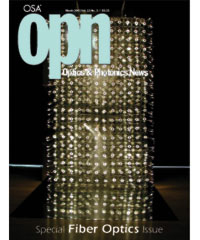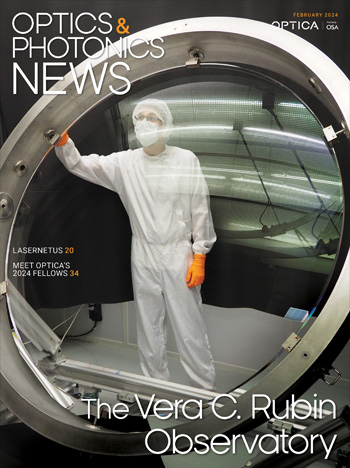
March 2002 Issue
- Photonic Crystal Fibers: New Solutions in Fiber Optics
- Multiple Optical Carrier Generation from a Supercontinuum Source
- Too Much Fiber?
- The Processing Power of Light
- New Developments in the Analysis of High-Speed Optical Communications Signals (OPN Trends Supplement)
- Coarse WDM Transceivers (OPN Trends Supplement)
- All-Optical Label Swapping for the Future Internet
- Chromatic Dispersion and Polarization-Mode Dispersion (OPN Trends Supplement)
- From the Guest Editor: An Overview of Optical Communiciations
- Nonlinear Propagation and Information Theory (OPN Trends Supplement)
- VCSELs Go the Distance
- Browse all Issues
Feature Articles
Photonic Crystal Fibers: New Solutions in Fiber Optics
Optical fibers with tiny air holes running along their length have recently aroused great excitement due to their unusual optical properties and their potential for device design. The article describes the new fiber waveguide forms enabled by this technology.
by Jonathan Knight,Tim Birks, Brian Mangan, and Philip St. James RussellMultiple Optical Carrier Generation from a Supercontinuum Source
The article reviews the generation of multiple optical carriers from a supercontinuum multicarrier source (SC-MCS). Advantages of SC-MCS include fixed channel spacing with microwave-oscillator (Hz) accuracy and the capability to generate a stream of more than 100 channels. In the future, SC-MCS will play a key role in applications such as WDM systems and optical frequency standards.
by Hidehiko TakaraToo Much Fiber?
Although long-distance networks have unused capacity, many analysts say that does not add up to bandwidth glut. Internet and voice network traffic is expected to double every year for the rest of the decade, and the unused capacity will allow plenty of room for networks to grow without the installation of new fiber.
by Neil SavageThe Processing Power of Light
The next few years should be exciting as the battle of optics versus electronics plays out in developing communication systems. Dynamic reconfigurability, network efficiency, and wavelength management will be the determining factors behind new technology development. Both optically transparent band-switching fabrics and all-optical waveband converters are expected to play an important role in meeting these requirements.
by Larry Marshall and Gabriel KraNew Developments in the Analysis of High-Speed Optical Communications Signals (OPN Trends Supplement)
As digital communication transmission speeds increase by factors of four and ten, measurement equipment is straining to stay ahead. This article reviews some recent breakthroughs in measurement techniques for waveforms at 40 Gbit/s and faster.
by Greg LeCheminantCoarse WDM Transceivers (OPN Trends Supplement)
As high-end DWDM technology becomes pervasive in long-haul networks, WDM technologies smaller in cost and size are emerging for short-distance local area network and access applications. For example, tiny coarse-WDM transceiver modules will soon integrate a multiwavelength array of lasers and an optical multiplexer and demultiplexer.
by Brian E. LemoffAll-Optical Label Swapping for the Future Internet
All-optical label swapping (AOLS), an approach to transparently route IP packets all-optically, can revolutionize the future Internet. AOLS uses optical encapsulation to route packets independent of their bit-rate, format or length. Photonic technologies like rapidly tunable all-optical wavelength converters play a key role in realizing AOLS. This article also covers semiconductor optical amplifier and nonlinear optical-fiber-based wavelength converter implementations. Results of an AOLS systems demonstration with 40-Gbit/s packets are shown.
by Daniel J. BlumenthalChromatic Dispersion and Polarization-Mode Dispersion (OPN Trends Supplement)
The field of optical communications systems has enjoyed a period of explosive growth in terms of the capacity that can be transmitted over a single fiber cable. This trend has been fueled by the increase in data-rate-per-channel, coupled with the increase in the total number of parallel wavelength channels. The total number of wavelength-division-multiplexed (WDM) channels that can be accommodated in a system depends on a range of factors, including cost, information spectral efficiency, nonlinear effects, and component wavelength selectivity. This article will deal with some of the critical limiting issues associated with the transmission of the ever-increasing data rate of each channel, chief among these chromatic dispersion (CD) and polarization-mode dispersion (PMD).
by Alan E.WillnerFrom the Guest Editor: An Overview of Optical Communiciations
This issue of Optics and Photonics News and its supplement, OPN Trends, focus on research directions in the field of optical communication systems. The goal is to provide a bird's eye view of the status--as well as a brief look into the future--of the technologies that will help define the role of photonics in information technology.
by Peter J. Delfyett, Jr.Nonlinear Propagation and Information Theory (OPN Trends Supplement)
Through widespread usage, the word “information” has come to have a tangible, concrete feel to it. Today we speak glibly of information flow and of information superhighways. Information is an abstraction, nevertheless, and it speaks to the insights of Claude Shannon1 that we have a formal theory that allows us to describe in fairly precise terms the flow of information through a communication channel. Although the basic formalism is quite general, information theory was initially developed in the context of telephonic communication through copper cable, and dealt mostly with a linear propagation channel, as exemplified by Shannon’s famous formula for the capacity of a channel (Table 1) with additive white Gaussian noise (AWGN). Such a channel is defined by a linear relationship between the output time series Y(t) and input X(t) through the relation Y(t) = X(t) + N(t), where N(t) is a Gaussian noise process with a flat power spectrum. All three processes are assumed to be bandlimited with a bandwidth W. The capacity of this channel is given by C=W log2(1+S/N), where S and N are the signal and noise powers, respectively.
by Partha P. Mitra, Jason B. Stark, and Andrew G. GreenVCSELs Go the Distance
Vertical-cavity surface-emitting la- sers (VCSELs) have come a long way in the past decade, evolving from a laboratory curiosity to a key component in fiber-optic communications in local area networks (LANs). Rapid advances are reported in 1.5-1.6-µm wavelength VCSELs with tunability and long-reach single-mode fiber transmission. With proven cost benefits in LAN applications, VCSELs are poised to meet the rising market demands of metropolitan area applications.
by P. Kner, D. Sun, J. Boucart, P. Floyd, R. Nabiev, D. Davis,W.Yuen, M. Jansen, C. J. Chang-HasnainDepartments and Columns
White House Science Advisors on Board
Despite the political successes of his first year and his sky-high public approval ratings, President Bush is distrusted by some in the scientific community, in part because of what scientists perceive as his tepid support for the federal science agencies and his lack of technological savvy.
Students, Scientists, and Optics
“Students, Scientists, and Optics,” is a collaboration between the Lincoln School of Brookline, Massachusetts, and Northeastern University’s Optical Science Laboratory. The 13-week program, held every year, features activities for gifted and talented fifth graders in the Brookline Public Schools.
Using Newsgroups
In this age of almost universal Internetconnectivity among people whose avocation or vocation involves technology, a surprising number of OSA members do not know how to view newsgroups. In this month’s “Electronic Information” column, we describe newsgroups and how to access them.
Antitrust Issues in Intellectual Property Licensing
The two most recent “Legal Lens” columns addressed the basics of antitrust law and its relationship with intellectual property (“IP”). This month’s column focuses on the role antitrust laws play in IP licensing.

![A multiplexed image of a human tonsil acquired. [NIAID] using the iterative bleaching extends multiplexity (IBEX) method.](https://opnmedia.blob.core.windows.net/$web/opn/media/images/articles/2024/0424/departments/202404-cover-web.jpg?ext=.jpg)

